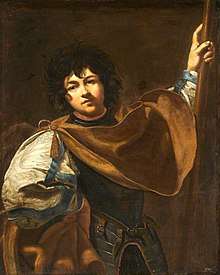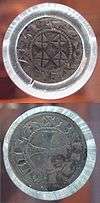William X, Duke of Aquitaine
William X (Guillém X in Occitan) (1099 – 9 April 1137), called the Saint, was Duke of Aquitaine, Duke of Gascony, and Count of Poitou (as William VIII) from 1126 to 1137. He was the son of William IX by his second wife, Philippa of Toulouse.
William X, Duke of Aquitaine | |
|---|---|
 William X of Aquitaine by Simon Vouet | |
| Born | 1099 Toulouse |
| Died | 9 April 1137 (aged 37–38) Santiago de Compostela, Spain |
| Noble family | Poitiers |
| Spouse(s) | Aenor de Châtellerault |
| Father | William IX, Duke of Aquitaine |
| Mother | Philippa of Toulouse |
William was born in Toulouse during the brief period when his parents ruled the capital. His birth is recorded in the Chronicle of Saint-Maixent for the year 1099: Willelmo comiti natus est filius, equivoce Guillelmus vocatus ("a son was born to Count William, named William like himself"). Later that same year, much to Philippa's ire, Duke William IX mortgaged Toulouse to Philippa's cousin, Bertrand of Toulouse, and then left on Crusade.

Philippa and her infant son William X were left in Poitiers. When Duke William IX returned from his unsuccessful crusade, he took up with Dangerose, the wife of a vassal, and set aside his rightful wife, Philippa. This caused strain between father and son, until 1121 when William X married Aenor de Châtellerault, a daughter of his father's mistress Dangerose by her first husband, Aimery.
William had three children with Aenor:
- Eleanor, who later became heiress to the Duchy; and is best known to history as Eleanor of Aquitaine;
- Petronilla, who married Raoul I of Vermandois;
- William Aigret, who died at age 4 in 1130, about the time their mother Aenor de Châtellerault died.
He possibly had one natural son, William. For a long time it was thought that he had another natural son called Joscelin and some biographies still erroneously state this fact, but Joscelin has been shown to be the brother of Adeliza of Louvain. The attribution of Joscelin as a son of William X has been caused by a mistaken reading of the Pipe Rolls pertaining to the reign of Henry II, where 'brother of the queen' has been taken as Queen Eleanor, when the queen in question is actually Adeliza of Louvain.
William administered his Aquitaine duchy as both a lover of the arts and a warrior. He became involved in conflicts with Normandy (which he raided in 1136, in alliance with Geoffrey V, Count of Anjou who claimed it in his wife's name) and for France.
Even inside his borders, William faced an alliance of the Lusignans and the Parthenays against him, an issue resolved with total destruction of the enemies. In international politics, William X initially supported antipope Anacletus II in the papal schism of 1130, opposite to Pope Innocent II, against the will of his own bishops. In 1134 Saint Bernard of Clairvaux convinced William to drop his support to Anacletus and join Innocent.
In 1137 William joined the pilgrimage to Santiago de Compostela, but died during the trip.[1] On his deathbed, he expressed his wish to see king Louis VI of France as protector of his fifteen-year-old daughter Eleanor, and to find her a suitable husband. Louis VI naturally accepted this guardianship and married the heiress of Aquitaine to his own son, Louis VII.
See also
- Dukes of Aquitaine family tree
Notes
- Bernard F. Reilly, 187.
References
- Parsons, John Carmi. Eleanor of Aquitaine: Lord and Lady, 2002
- Bernard F. Reilly, The Contest of Christian and Muslim Spain, 1031-1157, Blackwell Publishing, 1995.
John of Salisbury's Memoirs of the Papal Court translated from the Latin with introduction and notes by Marjorie Chibnall
| French nobility | ||
|---|---|---|
| Preceded by William IX |
Duke of Aquitaine 1126–1137 |
Succeeded by Eleanor |
| Count of Poitiers 1126–1137 | ||